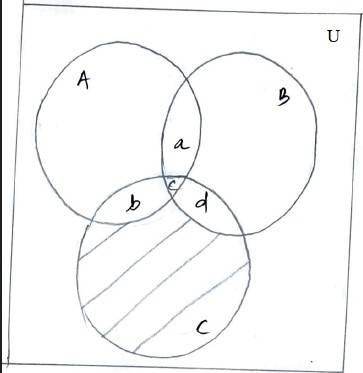64. In a survey it was found that 21 people liked product A, 26 liked product B and29 liked product C. If 14 people liked products A and B, 12 people liked productsC and A, 14 people liked products B and C and 8 liked all the three products.Find how many liked product C only.
64. In a survey it was found that 21 people liked product A, 26 liked product B and29 liked product C. If 14 people liked products A and B, 12 people liked productsC and A, 14 people liked products B and C and 8 liked all the three products.Find how many liked product C only.
-
1 Answer
-
64. Let A, B and C be the set of people who like product A, B and C respectively.
Then,
Number of people who like product A, n (A) = 21
Number of people who like product B, n (B) = 26
Number of people who like product C, n (C) = 29.
Number of people likes both product A and B, n (AB) = 14
Number of people likes both product A and C, n (AC) = 12
Number of people likes both product B and C, n (BC) = 14.
No. of people who likes all product, n (ABC) = 8

a→n (AB)
b→n (AC)
d→n (BC)
c→n (ABC)
From the above venn diagram we can see that,
Number of people who likes product C only
= n (C) - b - d + c
= n (C) - n (AC) - n (BC) + n (ABC)
= 29
...more
Similar Questions for you
(|x| - 3)|x + 4| = 6

(-x - 3) (- (x + 4) = 6
(x + 3) (x + 4) = 6 ⇒ x² + 7x + 12 = 6 ⇒ x² + 7x + 6 = 0
(x + 1) (x + 6) = 0 ⇒ x = -6 (since x < -4)
Case (ii) -4 ≤ x < 0
(-x - 3) (x + 4) = 6
⇒ -x² - 7x - 12 = 6
⇒ x² + 7x + 18 = 0
The discriminant is D = 7² - 4 (1) (18) = 49 - 72 < 0, so no real solution.
Case (iii) x ≥ 0
(x - 3) (x + 4) = 6
⇒ x² + x - 12 = 6
⇒ x² + x - 18 = 0
x = [-1 ± √ (1² - 4 (1) (-18)] / 2 = [-1 ± √73] / 2
Since x ≥ 0 ⇒ x = (√73 - 1) / 2
Only two solutions.
Given n = 2x. 3y. 5z . (i)
On solving we get y = 3, z = 2
So, n = 2x. 33. 52
So that no. of odd divisor = (3 + 1) (2 + 1) = 12
Hence no. of divisors including 1 = 12
Let A = {a, b, c}, B = {1, 2, 3, 4, 5} n (A × B) = 15
x = number of one-one functions from A to B.
y = number of one-one functions for A to (A × B)
2cos
RHS 2
66. Given series is 1× 2× 3 + 2× 3 ×4 + 3× 4 ×5 + … to n term
an = (nth term of A. P. 1, 2, 3, …) ´× (nth terms of A. P. 2, 3, 4) ×
i e, a = 1, d = 2- 1 = 1i e, a = 2, d = 3- 2 = 1
(nth term of A. P. 3, 4, 5)
i e, a = 3, d = 3 -4 = 1.
= [1 + (n -1) 1] ×[2 + (n -1):1]× [3 + (n- 1) 1]
= (1 + n -1)×(2 + n -1)×(3 + n -1)
= n (n + 1)(n + 2)
= n(n2 + 2n + n + 2)
=n3 + 2n2 + 2n.
Sn = ∑n3 + 3 ∑n2 + 2 ∑n
=
=
Taking an Exam? Selecting a College?
Get authentic answers from experts, students and alumni that you won't find anywhere else
Sign Up on ShikshaOn Shiksha, get access to
- 65k Colleges
- 1.2k Exams
- 679k Reviews
- 1800k Answers
